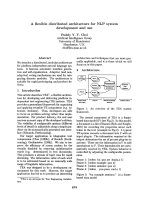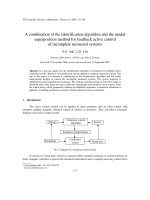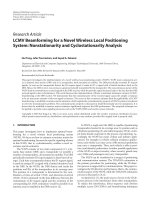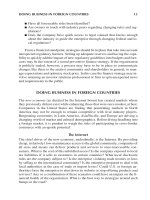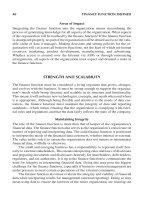System identification and autonomous flight controller desing for small scaled unmanned helicopter
Bạn đang xem bản rút gọn của tài liệu. Xem và tải ngay bản đầy đủ của tài liệu tại đây (12.57 MB, 83 trang )
逢
甲
大
學
機械與航空工程博士學位
學博士學位論文
基於自適應學習和模型預測控制
的小型無人直升機自主飛行控制
器設計與系統識別
System Identification and Autonomous Flight
Controller Design Based on Adaptive LearningBased and Model Predictive Control for a
Small-Scaled Unmanned Helicopter
指導教授: 葉俊良教授
共同指導教授: 賴盈誌 教授
博士生: 黎志光
中 華 民 國 一 百 零 八 年 五 月
System Identification and Autonomous Flight Controller Design Based on Adaptive
Learning-Based and Model Predictive Control for a Small-Scaled Unmanned Helicopter
Acknowledgements
First, I would like to express my sincere gratitude to my advisors, Prof. Chun-Liang Yeh
and Prof. Ying-Chih Lai, for their guidance, support, and attention not only in research but
also in my life throughout the time of my study in Feng Chia University. Having motivation,
immense knowledge, and strategic vision, Professors have given invaluable advice, criticism,
suggestions, and encouragement to me for doing the right research direction. It is an excellent
chance to study under their supervision. My special thank for Prof. Ying-Chih Lai, this
dissertation would not have been completed without his help, patience and time.
In addition, I am thankful to my committee members for their time to review my works
and dissertation as well as their valuable comments, questions and suggestions to make this
dissertation more completed.
My thanks also extend to officers in FCU, especially Prof. Wen-Chin Tsai who has
guided me the rules of the university as well as administrative procedures. Besides, I thank all
my LABmates at Lab 309, Science and Aeronautical Engineering Building for sharing works
and living to me. Moreover, I would like to thank my Vietnamese friends at Feng Chia
University who usually join and play together with me during study time.
Finally, I am very grateful to my family, to my parents for their unwavering support and
encouragement, to my wife and children for always staying beside and helping me overcome
any difficulty, and to my brothers and sisters for their assistance.
i
FCU e-Theses & Dissertations (2019)
System Identification and Autonomous Flight Controller Design Based on Adaptive
Learning-Based and Model Predictive Control for a Small-Scaled Unmanned Helicopter
Abstract
The dynamic models of a helicopter are highly nonlinear and change dramatically among
different flight conditions, such as hovering, cruising, taking off, and landing. Since the
longitudinal and lateral motions are highly coupling, the system identification and control
system design of a helicopter still remain challenging because of its inherent complex
dynamic movements. These nonlinear dynamics can be linearized by the concept of stability
derivatives according to a specific trim condition. The full state-space model has more than
30 unknown parameters in the system matrix, A, and control matrix, B. Determining all of
these parameters is impractical. Therefore, the full model is suggested broken into subsystems such as pitch, roll, yaw, and heave models; then the subspace method is applied to
reconstruct and determine initial values. Finally, the prediction error estimate (PEM) is
utilized to improve the accuracy of the estimated models. On the other hand, the yaw
response oscillates more than other attitude motions due to inherent nonlinearity. In this
study, the yaw dynamic is considered as a second-order system for the yaw rate state
variable. Then unknown parameters are estimated by Levenberg-Marquardt (LM) method.
Based on the derived models, the integration of model predictive control (MPC),
Laguerre function, and exponential data weighting is proposed to control pitch, roll, and
heave motions. The Laguerre function is utilized to reduce the matrix size in the optimization
procedure of MPC, which can reduce the computing load of the onboard computer.
Moreover, the exponential data weighting is adopted to modify the original cost function for
solving the numerical conditioning problem, and it is able to increase the stability of the flight
control system. Due to a limitation of the sub-systems, which cannot solve the coupled
dynamic, the online dynamic inversion is proposed based on the recursive learning algorithm,
which is regarded as an online adaptation and its output signal is added to the control system.
This approach is able to solve the limitation caused by using subsystems as mentioned above.
On the other hand, in this article, the adaptive control based on neural approximation is
proposed to control the yaw motion. By using the Lyapunov stability theory, the off-line
training process is not a requirement. The weight matrix is updated online. By using the
proposed method, the measured error and effect of the environmental disturbance are
eliminated. The designed control system is verified and compared with the fuzzy controller
under ideal and turbulent environments. The simulation results show that the proposed
method performs much better than that of fuzzy.
ii
FCU e-Theses & Dissertations (2019)
System Identification and Autonomous Flight Controller Design Based on Adaptive
Learning-Based and Model Predictive Control for a Small-Scaled Unmanned Helicopter
Finally, the proposed solutions are implemented by C language in a HIL system. Then
feasibility verification is performed in the developed simulation environment. Simulation
Results have shown that the performance of the proposed method is significantly better than
that of H∞, and it has the potential to apply in practice.
Keywords
Model predictive control; system identification; neural network; adaptive control
iii
FCU e-Theses & Dissertations (2019)
System Identification and Autonomous Flight Controller Design Based on Adaptive
Learning-Based and Model Predictive Control for a Small-Scaled Unmanned Helicopter
摘要
直升機的動態模型具有高度非線性的,並且在不同的飛行條件下發生顯著變化,
例如懸停,巡航,起飛和著陸。由於縱向和橫向運動是高度耦合的,因此直升
機的系統識別和控制系統設計由於其自然複雜的動態運動且仍然具有挑戰性。
非線性方程可以根據特定的修整條件通過穩定性導數的概念線性化,完整的狀
態空間模型在系統矩陣 A 和控制矩陣 B 中具有 30 多個未知參數,確定所有這些
參數是不容易。因此,可將完整模型分解為子系統,例如俯仰,滾轉,偏航和
升沈模型,然後使用子空間方法重建和確定初始值,再利用預測誤差估計(PEM)
來提高估計模型的準確性。另一方面,由於固有的非線性,偏航響應比其他姿
態運動振盪得更多。在該研究中,偏航動態被認為是偏航率狀態變量的二階系
統,然後由 Levenberg-Marquardt(LM)估計未知參數。
基於導出模型,提出了模型預測控制(MPC),Laguerre 函數,指數數據加權
的集成來控制俯仰,滾轉和升降運動。其中,Laguerre 函數用於減小 MPC 優化
過程中使用的矩陣大小,這可以減少載具計算機的計算負荷。此外,採用指數
數據加權來修改原始成本函數以解決數值調節問題,並且能夠提高飛行控制系
統的穩定性。由於子系統的局限性,無法解決耦合動態問題,因此提出了基於
遞歸學習算法的在線動態反演,該算法被視為在線自適應,其輸出信號被添加
到控制系統中,此方法有助於解決上面提到的使用子系統造成的限制。
另一方面,在本文中,基於類神經的自動調整控制使控制偏航運動的提出的解
決方案,使用 Lyapunov 穩定性理論,載具不需離線訓練過程。採用權重矩陣能
iv
FCU e-Theses & Dissertations (2019)
System Identification and Autonomous Flight Controller Design Based on Adaptive
Learning-Based and Model Predictive Control for a Small-Scaled Unmanned Helicopter
在線更新,可消除了測量的誤差和環境干擾的影響。所設計的控制系統在理想
和風擾環境下經過驗證並與模糊控制器進行比較,模擬結果表明,該方法的性
能優於模糊方法。最後,提出的解決方案由 C 語言實現在 HIL 系統中,然後所
在開發的模擬環境上驗證可行性。模擬結果表明,該方法的性能明顯優於 H∞,
它有可能在實踐中應用。
關鍵詞
模型預測控制; 系統識別; 神經網絡; 自適應控制
v
FCU e-Theses & Dissertations (2019)
System Identification and Autonomous Flight Controller Design Based on Adaptive
Learning-Based and Model Predictive Control for a Small-Scaled Unmanned Helicopter
Contents
Acknowledgements .......................................................................................................... i
Abstract ........................................................................................................................... ii
Keywords ................................................................................................................... iii
Contents ......................................................................................................................... vi
List of Figures ................................................................................................................ ix
List of Tables ................................................................................................................ xii
Chapter 1 Introduction ..................................................................................................... 1
1.1.
Background ..................................................................................................... 1
1.2.
Literature Review ............................................................................................ 2
1.3.
Motivation and Objectives ............................................................................... 7
1.4.
Dissertation Overview...................................................................................... 8
Chapter 2 Unmanned Helicopter Mathematical Model..................................................... 9
2.1. Equations of Motion ............................................................................................. 9
2.2. Rotation Equation ............................................................................................... 10
2.3. Main Rotor Dynamic and Tail Rotor Dynamic ................................................... 11
2.4. Overall Model .................................................................................................... 13
2.5. Yaw Dynamic..................................................................................................... 14
2.6. Interim Summary................................................................................................ 16
Chapter 3 System Identification..................................................................................... 17
3.1. Helicopter Sub-models ....................................................................................... 17
3.2. Subspace Estimation Method .............................................................................. 18
3.3. PEM ................................................................................................................... 19
3.4. Online Modeling of the Attitude ......................................................................... 19
3.5. Levenberg–Marquardt Method ........................................................................... 21
3.6. System Identification Procedure ......................................................................... 21
3.7. Identification Results .......................................................................................... 24
vi
FCU e-Theses & Dissertations (2019)
System Identification and Autonomous Flight Controller Design Based on Adaptive
Learning-Based and Model Predictive Control for a Small-Scaled Unmanned Helicopter
3.7.1. Identity Results using the PEM and Subspace Method ................................. 24
3.7.2. Identity Results of Online Modeling Using RBFNN .................................... 25
3.7.3. Identity Results of Yaw Dynamic Using LM method ....................................... 26
3.8. Interim Summary................................................................................................ 27
Chapter 4 Development of Autonomous Flight Controllers............................................ 27
4.1. Adaptive Tracking Control Based on Neural Approximation for the Yaw Motion
....................................................................................................................................... 28
4.1.1. The Adaptation Law .................................................................................... 28
4.1.2. Stability Analysis ........................................................................................ 30
4.1.3. Algorithm of the Design System .................................................................. 31
4.1.4. Simulation Results and Discussions ............................................................. 34
4.2. Online Adaptive Learning-Based and Model Predictive Control with Exponential
Data Weighting ............................................................................................................... 37
4.2.1. Discrete-Time Model Predictive Control ..................................................... 38
4.2.2. Exponential Data Weighting Algorithm ....................................................... 39
4.2.3. Algorithm .................................................................................................... 40
4.2.4. Procedure of Tuning Parameters and Analysis of Stability ........................... 42
4.2.5. Adaptive Learning-Based Algorithm for Pitch and Roll Motion .................. 43
4.2.6. Architecture of the Autonomous Flight Controller ....................................... 45
4.3. Interim Summary................................................................................................ 47
Chapter 5 Development of a Simulation Environment ................................................... 48
5.1. Raspberry Pi3 Model B Characteristic ................................................................ 48
5.2. Settling the network on X-Plane ......................................................................... 49
5.3. Hardware-In-The-Loop....................................................................................... 51
5.3. Simulation .......................................................................................................... 53
5.3.1. Ideal Environment ....................................................................................... 53
5.3.2. Disturbance Environment ............................................................................ 56
vii
FCU e-Theses & Dissertations (2019)
System Identification and Autonomous Flight Controller Design Based on Adaptive
Learning-Based and Model Predictive Control for a Small-Scaled Unmanned Helicopter
5.4. Interim Summary................................................................................................ 60
Chapter 6 Conclusions................................................................................................... 61
6.1. Summary of Contribution ................................................................................... 61
6.2. Future Work ....................................................................................................... 62
Reference ...................................................................................................................... 63
Biography ..................................................................................................................... 68
Publications ................................................................................................................... 69
Conferences .................................................................................................................. 69
viii
FCU e-Theses & Dissertations (2019)
System Identification and Autonomous Flight Controller Design Based on Adaptive
Learning-Based and Model Predictive Control for a Small-Scaled Unmanned Helicopter
List of Figures
Figure 2.1 The definition of the fixed frame[2] .............................................................. 10
Figure 3. 1 RBFNN approximation ................................................................................ 20
Figure 3. 2 RBFNN configuration ................................................................................. 20
Figure 3. 3 Diagram of the SIL for collecting flight data ................................................ 22
Figure 3. 4 Flowchart of the system identification procedure; (a) combination of subspace
and PEM method; (b) using LM method ............................................................................. 22
Figure 3. 5 Structure of the SIL control system .............................................................. 23
Figure 3. 6 Specified input for system identification ...................................................... 23
Figure 3. 7 Estimated results of pitch dynamic motion ................................................... 24
Figure 3. 8 Estimated results of roll dynamic motion ..................................................... 24
Figure 3. 9 Estimated results of yaw dynamic motion .................................................... 25
Figure 3. 10 Estimated results of heave dynamic motion ............................................... 25
Figure 3. 11 Online estimated results of roll angle ......................................................... 26
Figure 3. 12 Online estimated results of pitch angle ....................................................... 26
Figure 3. 13 Online estimated results of yaw angle ........................................................ 26
Figure 3. 14 Result of the yaw motion identification ...................................................... 27
Figure 4.1 RBF neural network structure ....................................................................... 28
Figure 4.2 Diagram of the system .................................................................................. 32
Figure 4.3 Control scheme of the developed system ...................................................... 33
Figure 4.5 (a) Ideal condition; (b) Turbulent condition .................................................. 35
Figure 4.6 Results of the fuzzy and RBF under ideal environment ................................. 35
Figure 4.7 Results of the fuzzy and RBF under turbulent environment........................... 36
Figure 4.8 Error of yaw angle in an ideal condition........................................................ 36
Figure 4.9 Error of yaw angle in a turbulent condition ................................................... 37
Figure 4.10 Yaw rate and approximation value .............................................................. 37
Figure 4.11 Flowchart of DMPC design ........................................................................ 41
ix
FCU e-Theses & Dissertations (2019)
System Identification and Autonomous Flight Controller Design Based on Adaptive
Learning-Based and Model Predictive Control for a Small-Scaled Unmanned Helicopter
Figure 4.12 Scheme of the proposed helicopter control based on Laguerre function....... 41
Figure 4.13 Comparison of the eigenvalues of the original design and that/those of
exponential weighting; (a) pitch; (b) roll; (c) heave. ............................................................ 43
Figure 4.14 Scheme of adaptive learning-based controller ............................................. 43
Figure 4.15 Illustration of coupled effect of lateral-longitudinal dynamic without using
dynamic inversion ............................................................................................................... 45
Figure 4.16 Illustration of coupled effect of lateral-longitudinal dynamic using dynamic
inversion ............................................................................................................................. 45
Figure 4.17 Control scheme of the developed control system ......................................... 46
Figure 4.18 Block diagram of outer-loop controller ....................................................... 46
Figure 4.19 Block diagram of inner-loop controller ....................................................... 47
Figure 5.1. Pin’s Diagram of Raspberry Pi3 Model B ( .... 48
Figure 5.2. UDP packet format of label 18..................................................................... 49
Figure 5.3. Input/output data selecting window.............................................................. 50
Figure 5.4. IP configuration ........................................................................................... 50
Figure 5.5. Ports configuration ...................................................................................... 50
Figure 5.6. UDP port ..................................................................................................... 51
Figure 5.7 Block diagram of structure of HIL ................................................................ 51
Figure 5.8 Block diagram of processing sequence in Raspberry Pi 3 .............................. 52
Figure 5.9 The user interface coded in C#...................................................................... 52
Figure 5.10 Hardware-In-The-Loop ............................................................................... 52
Figure 5.11 Response to pitch control ............................................................................ 53
Figure 5.13 Response to yaw control ............................................................................. 54
Figure 5.14 Velocity via y direction............................................................................... 54
Figure 5.15 Velocity via x direction............................................................................... 55
Figure 5.16 Velocity via z direction ............................................................................... 55
Figure 5.17 Response to altitude control ........................................................................ 55
x
FCU e-Theses & Dissertations (2019)
System Identification and Autonomous Flight Controller Design Based on Adaptive
Learning-Based and Model Predictive Control for a Small-Scaled Unmanned Helicopter
Figure 5.18 3D tracking trajectory ................................................................................. 56
Figure 5.19 Response to pitch control ............................................................................ 57
Figure 5.20 Response to roll control .............................................................................. 57
Figure 5.21 Response to yaw control ............................................................................. 57
Figure 5.22 Velocity via x direction............................................................................... 58
Figure 5.23 Velocity via y direction............................................................................... 58
Figure 5.24 Velocity via z direction ............................................................................... 58
Figure 5.25 Response to the altitude control .................................................................. 59
Figure 5.26 3D tracking trajectory ................................................................................. 59
xi
FCU e-Theses & Dissertations (2019)
System Identification and Autonomous Flight Controller Design Based on Adaptive
Learning-Based and Model Predictive Control for a Small-Scaled Unmanned Helicopter
List of Tables
Table 2.1 Nomenclature ................................................................................................ 12
Table 3.1. The predicted values ..................................................................................... 26
Table 5.1 The mean error of the velocity in three direction motions ............................... 56
Table 5.2 The mean error of the position in three direction motions ............................... 56
Table 5.3 The average error value of the velocity in three direction motions .................. 59
Table 5. 4 The average error value of the position in three direction motions ................. 59
xii
FCU e-Theses & Dissertations (2019)
System Identification and Autonomous Flight Controller Design Based on Adaptive
Learning-Based and Model Predictive Control for a Small-Scaled Unmanned Helicopter
Chapter 1 Introduction
1.1. Background
An unmanned helicopter has widely been applied in military and civilian, mainly due to
its ability to hover, fly in very low altitude, and vertical take-off /landing (VTOL). However,
due to model nonlinearities and inherent instabilities, controller design and system
identification for autonomous flights remain a challenge. General, rotorcraft unmanned
aircraft system (RUAS) can be categorized into five classes basis of size and payload [1].
Category I: Full-scale unmanned helicopter: the remark attributes is that carry a safety
pilot onboard the vehicle. It often uses a complex and risky flight test, for example, the
Boeing Unmanned Little Bird (ULB) helicopter.
Category II: Medium-scale UAS such as Yamaha RMAX: Hirobo SkySurveyor, and so
on, its payload is significant (more than 10 kg) to carry high-quality navigation and mission
sensors. Therefore, it can perform a complex flight task. It is well-engineered with some level
of dependability.
Category III: Small-scale RUAS such as Vario Benzin Trainer, Bergen Industrial Twin,
Hirobo, and so on: It is developed based on RC helicopters with optionally integrated
autopilot. Although its payload is limit (2 to 10 kg), most of the navigation and mission
sensors are integrated. Therefore, it can be converted from RC helicopters to dependable
UAS.
Category IV: Mini RUAS: It can carry payload less than 2 kg and use small conventional
avionics and lightweight perception sensors. Because of safe operation, it is excellent choice
for research.
Category V: Finally, micro air vehicles such as Epson micro flying robot: its payload is
less than 100g. Hence, it often is used to indoor application and controlled by handle.
The categories I, II, and III are the conventional helicopter configurations with a single
main rotor and a tail rotor. The categories IV and V are multi-rotor platforms such as
quadrotors and coaxial vehicles. The flight capabilities of a rotor-aircraft is different than
fixed-wing. It can maintain the same position in the air that is called hover. This chapter will
present an overview of concepts and the problems that need to be solved in the unmanned
helicopter area such as system identification and control algorithm.
1
FCU e-Theses & Dissertations (2019)
System Identification and Autonomous Flight Controller Design Based on Adaptive
Learning-Based and Model Predictive Control for a Small-Scaled Unmanned Helicopter
1.2.
Literature Review
Small-scale helicopter retain all attributes of the full-scale counterpart [2]. Due to reduced
size and cost, small-scale helicopter has gotten more and more attention from UAV
community for development of autonomous flight platforms. The challenges towards the
development of an autonomously flying helicopter involve measurement technique,
communication technique, system identification, and controller design. Moreover, helicopter
is high nonlinear system with significant dynamic coupling. The coupling problem contains
two points. The first point is the nonlinear equations of motion. The second point is the
dynamic coupling between the generated aerodynamic forces and moments. In addition, the
uncertainty of the model and parameters is related to the complicated aerodynamic nature of
the thrust generation. Hence, it is obvious that controller design and system identification for
a small-scale unmanned helicopter is challenging issues. Some remarkable points need to be
accounted before developing the flight controller as follows:
Determine parametric dynamic model that best describes the helicopter motion with
minimum order.
After deriving the parametric helicopter model, the feedback control laws need to
determine for control of helicopter operating following a predefined reference
trajectory
Finally, the control algorithm is implemented on embedded system based on the
derived parametric helicopter model.
The most popular techniques used for the helicopter modeling are the first-principles
technique, the system-identification technique, and combination of both methods. The firstprinciples technique [3] determines the mathematical equations of motion based on
fundamental laws of mechanics and aerodynamics. This method requires high-accurate
measurement devices and extensive knowledge of all the phenomena involved in the
helicopter dynamics. System identification methods are adopted to build mathematical
models for dynamic systems by using the measured input/output data. For rotor aircraft, the
Comprehensive Identification from Frequency Responses (CIFR), developed by the National
Aeronautics and Space Administration (NASA), is the most popular. This toolbox is based on
a comprehensive frequency-response approach to extracting dynamic models from flight test
data analysis. The validation step is performed in the time domain. Because of achieving the
requirement of the accurate model at high frequencies, many researchers have applied it to
2
FCU e-Theses & Dissertations (2019)
System Identification and Autonomous Flight Controller Design Based on Adaptive
Learning-Based and Model Predictive Control for a Small-Scaled Unmanned Helicopter
identify full-state models for both hovering and cruise mode [4, 5], for example, Yamaha R50, X-Cell 60, and Thunder Tiger Raptor 50 V2. In the time domain, NASA also developed
another system identification toolbox, termed System Identification Programs for Aircraft.
Wei Yuan successfully applied SIDPAC to estimate the full model of a helicopter at hover
mode [6]. Besides, several other identification approaches have been utilized [7] including
observer/Kalman filter identification (OKID) method [8-13], prediction error minimization
(PEM) [14], recursive least square [15, 16], and subspace [17]. Intelligent approaches, such
as neural network (NN), Fuzzy logic [18, 19], genetic algorithm (GA), and deep learning [20]
are also applied in system identification due to the advances in computer science and artificial
intelligence technology [21-24]. Wherein subspace can deal with multi-input-multi-output
(MIMO) system without the requirement of the extensive knowledge about the system model.
Moreover, because of the ability of reconstruction of the system model based on the Kalman
state sequence ( ) [25, 26], the subspace is a useful solution to identify a linear system,
especially for large datasets. In practice, subspace is often used to generate the initial value
since the combination with PEM. In this study, the subspace and PEM are the adopted
solution for reconstructing and identifying the subsystems of a used helicopter.
Otherwise, because of the coupled dynamic, the full state-space model is required since
linearization contains uncertainties for high dynamic motions and transitions between
different flight conditions. Also, multiple operation points have to be identified to determine
the helicopter dynamic in the entire operating envelope. It requires high effort and budget to
conduct the experiments. Therefore, the simpler solution is to construct the full model into
the subsystems, including four independent single-input-single-output (SISO) feedback loop
concerning each control input, or two separate subsystems according to longitudinal-lateral
motion and yaw-heave movement. However, these approaches cannot guarantee a
mathematically consistent stability analysis. For overcoming this problem, Raptis et al. [2]
proposed an interconnection matrix in the yaw-heave dynamic subsystem to connect to the
lateral-longitudinal subsystem. Then two independent controllers are developed to control the
motion of each subsystem.
Since the dynamic models of helicopters and actuators are nonlinear. Nonlinear control,
such as fuzzy inference system, artificial NN, GA, swarm intelligence, and deep
reinforcement learning, is suitable for the flight control of helicopters in complex flight
conditions [27]. Among them, fuzzy logic and NN have been widely used. The construction
of fuzzy logic [28, 29] consists of fuzzification, rule-based inference, and defuzzification.
3
FCU e-Theses & Dissertations (2019)
System Identification and Autonomous Flight Controller Design Based on Adaptive
Learning-Based and Model Predictive Control for a Small-Scaled Unmanned Helicopter
Fuzzy logic is a well-known solution for handling uncertainty problems in nonlinear systems.
The controller rules are expressed by operator IF/THEN. The control rules entirely depend on
expert knowledge. In case of MIMO systems (complex systems), determining the rules is a
difficult task. Reaching the desired quality is thus also difficult. The performances of fuzzy
controllers are imperfect, if the applied systems have the characteristics of high order, time
variation, and random disturbance. Hence, fuzzy controllers are usually combined with other
methods, such as fuzzy-proportional–integral–derivative (PID) and Backstepping adaptive
fuzzy controllers.
Comparing with fuzzy logic, NN is also an excellent solution for nonlinear systems [30,
31]. An NN consists of three layers, namely, the input, hidden, and output layers. Mostly, the
NN needs offline training for controller development. Its self-learning capability helps
eliminate the complex mathematical problem in traditional methods. However, problems of
this solution are the impossible interpretation of the functionality and the difficult
determination of the number of layers and neurons [32]. Moreover, a central processing unit
on a small-scale unmanned helicopter is often limited in performance. Consequently, the
heavy computation load for deep reinforcement learning remains a challenge in practice.
From an implementation view, model-based controllers are more popular than nonlinear
algorithms since they are easy to implement and reduce the computational effort.
The flight control system of unmanned rotorcrafts [1, 33-35] can be categorized into
linear flight control system [36], model-based nonlinear controllers [37-41], and learningbased controllers [27, 31]. The PID controller belongs to the linear flight control systems,
operates based on the difference of a target value and a measured value. It is useful to design
a controller in practice since it does not required extensive knowledge about the dynamic
system and control gain can be empirically tuned. Four separate PIDs is utilized
corresponding to four independent inputs. PID was successfully used on the flight control
system of the Yamaha R50 helicopter at hover mode [36]. However, helicopter dynamic is
highly nonlinear and coupled and dramatically change due to the influence of the flight
environment. While the control gains are constant, it leads to limited performance. Therefore,
a linear model is often utilized to approximate the helicopter dynamic. Then the model-based
control methods are applied to control the operation of the helicopter, for example, the H
infinitive (H∞), the Model Predictive Control (MPC), Linear-Quadratic Regulator (LQR),
and so on.
4
FCU e-Theses & Dissertations (2019)
System Identification and Autonomous Flight Controller Design Based on Adaptive
Learning-Based and Model Predictive Control for a Small-Scaled Unmanned Helicopter
H∞ is a typical model-based robust controller. This controller uses the classical loopshaping concepts to the multivariable frequency response to acquire a good robust
performance. It has many outstanding attributes [42] in handing the problems of parametric
uncertainties, exogenous disturbances, and even payload changing circumstances [43].
Therefore, it is extensively applied in the unmanned aerial vehicles (UAVs), for example,
control of a small-scale helicopter at hover such as Yamaha R-50 and Raptor E620
helicopters [44, 45]. However, the flight validation showed that in the case of the
multivariable system, H∞ is preferable to design multiple feedback loops concerning
decoupled subsystems rather than developing the controller for the whole helicopter
dynamics [46].
LQR is an optimal controller. Based on the basis of the collected weighting factors and a
cost function is designed to minimize or eliminate errors between the desired and measured
values. This method was also applied to the autonomous control system of a UAV in [38].
One advantage of LQR is its capability to handle a complex dynamic system. However, LQR
control needs to access full states, which is impossible for many dynamic systems.
MPC is also the model-based approach, which uses an explicit model to predict future
output behavior and to track the error over a future horizon. This error is then minimized by
solving an optimal control problem. MPC can well handle multiple problems, including
system time delay, uncertainty parameters, and constraints of input and output variables [39,
40, 47]. Hence, it has been applied widely [48]. However, one process of MPC is required to
solve the optimization problem online for each sampling. Therefore, the traditional MPC is
not suitable for systems with low computing power. MPC also requires extensive memory to
store computational results. Therefore, a fast MPC has been proposed to boost the calculation
of the entire MPC control process offline. The online MPC system is to adopt a lookup table,
which is termed explicit MPC. However, one disadvantage of explicit MPC is that the table
size will increase exponentially when the horizon states and input’s dimension increase;
consequently, it is seldom applied to complex systems with numerous states and inputs.
Recently, the fast MPC has been developed as code generation for convex optimization [49],
and it works efficiently within a short sampling time depending on the problem size and
processor capability. This software package can automatically generate C code, which helps
reduce the development time of the system. Besides, model predictive control using Laguerre
function is also another good approach to reduce the number of states used in the online
5
FCU e-Theses & Dissertations (2019)
System Identification and Autonomous Flight Controller Design Based on Adaptive
Learning-Based and Model Predictive Control for a Small-Scaled Unmanned Helicopter
optimization procedure, which can increase the computational speed [50]. This method is
suitable for the small-scale unmanned helicopters due to the limitation of computing power.
The yaw angle expresses the rotational motion of the helicopter around the z-axis of the
reference coordinate system at the center of gravity. Yawing control with high accuracy in
complex environmental conditions has great significance in motion control of the helicopter
and execution of real tasks, such as, performing rescue missions in hard-to-reach areas (e.g.
performing sea rescues), inspecting electrical lines, monitoring forest fires, inventorying
wildlife, spraying pesticides in agriculture and so on. The problem is that the torque produced
by tail rotors, which compensates to that produced by the main rotor to maintain the stable
state of the helicopter, is unbalanced. Due to the unstable and inaccurate yaw dynamic
motion, particularly in the relatively high-frequency region, the yaw response oscillates more
than other attitude motions. Moreover, the yaw dynamic motion is inherently nonlinear. Its
input variables are nonlinear as illustrated by the general form
= ( , ), where x is the
state vector, u is the input, y is the output and f(.) denotes the given function. Yaw dynamic
becomes a non-affine nonlinear system. It is impossible to find such explicit linearizing
feedback to achieve feedback linearization. Therefore, the design of a controller for yaw
motion is a challenging issue. Following this aspect, the controllers can be classified
depending on how the problem is solved. In a direct non-affine method, the controller is
synthesized directly from non-affine dynamic. Due to the use of a more accurate
mathematical model, the designed controller gives high performance and works well in the
large stable region. However, the problem is how to handle the non-affine nonlinearities and
unknown/uncertain nonlinear terms in the helicopter dynamic. The proposed methods such as
adaptive fuzzy, adaptive neural network, sliding mode technique are widely applied in
solving this issue [51-54]. Some remarkable solutions are proposed in [55-59] for the UAV.
In [56], the mean value theorem and implicit function theorem were used as mathematical
tools to handle the non-affine problem in the control signal. The adaptive neural network was
then utilized to construct the controller for the helicopter in vertical flight. In [57] the authors
applied the terminal sliding mode control algorithm in controlling yaw motion of an
unmanned helicopter. The continuous function, filter, and disturbance estimator were
integrated into the system for solving the problem of chattering that is produced by the
discontinuous control signal. In [58], the invertible theory was used to avoid model
simplifications. A direct non-affine hybrid control is adopted to control the hypersonic flight
vehicle. Finally, the fusion of fuzzy wavelet neural network was applied to estimate unknown
6
FCU e-Theses & Dissertations (2019)
System Identification and Autonomous Flight Controller Design Based on Adaptive
Learning-Based and Model Predictive Control for a Small-Scaled Unmanned Helicopter
flight dynamic, which helps to design the controller against pragmatic uncertainties. Another
solution of fuzzy sliding mode technique, which considered non-affine nonlinear
aerodynamic coefficients, was utilized to handle non-affine problem [59]. A non-affine
MIMO attitude tracking controller is synthesized for the control of the hypersonic flight
vehicle. Its advantage is that the bounded values of the uncertainties, unmodeled dynamics,
and external disturbances do not require the exact value.
Synthesis of controllers for systems that are non-affine in control signal is a difficult task
[55]. Hence, indirect non-affine control method was proposed. Non-affine model is firstly
converted into the affine model by using Taylor series approach [60] and Mean Value
Theorem [61, 62]. Another proposed approach to obtain affine model [63] is that the dynamic
model rewritten as the linear affine formulation, then a robust nonlinear controller is applied
based on an out-feedback algorithm for velocity and altitude tracking. Because the original
dynamic of aircraft is highly nonlinear and non-affine, this conversion may not keep certain
key dynamics. Hence it affects the performance of the control approach, especially for
tracking control.
Moreover, an essential requirement of the tracking control algorithm is the robustness
against noise and minimal error. To deal with these problems, the Kalman-based active
observer controller [64] is an excellent solution to estimate the system state and disturbances.
It recoups the unmodeled terms for ensuring the overall stability of the system. Besides, the
sliding mode control is also a practical approach for tracking [65, 66]. The sliding mode
combines a smooth nonlinear control law for approximating unknown parameters [65].
Hence, controller performance is better with lower control efforts in comparison with the
pure sliding mode controller. Furthermore, synthesizing the Back-Stepping controller [67]
based on a path following error dynamic is also a practical solution for tackling the model
uncertainty and nonlinearity problem in tracking control.
1.3. Motivation and Objectives
The main challenges of helicopter control are shown in the following aspects:
The helicopter flight dynamics changes over the flight envelope depending on
flight mode including hover flight, forward flight, taking off or landing, and so on
Multivariable and coupling effects among the different axes of motion
7
FCU e-Theses & Dissertations (2019)
System Identification and Autonomous Flight Controller Design Based on Adaptive
Learning-Based and Model Predictive Control for a Small-Scaled Unmanned Helicopter
Disturbance sensitivity: under influence of the disturbance (Wind gust), the
aerodynamic will be changed. Especially, unmeasurable input disturbances require
high control bandwidth to eliminate noise effect
On the other hand, the autonomous hovering is one of the most significant flights
maneuvering for an unmanned helicopter. It has broad applications in various areas such as
pollution inspection and surveillance. Therefore, this dissertation will focus on three critical
problems including the system identification, controller design, and development of
simulation environment (hardware-in-the-loop - HIL).
The objective of this research is to identify the subsystems of a small-scale unmanned
helicopter and to develop of control algorithms that are able to enhance the performance of
the flight control system. The MPC based on the Laguerre function and the exponential data
weighting, and an adaptive learning-based controller are proposed. They are implemented by
C language on an embedded system, Raspberry Pi 3 Model B (Pi3B), and the feasibility are
verified in the developed simulation environment.
1.4. Dissertation Overview
The rest of the study is organized as follows: chapter 2 presents the equations of motion
of the helicopter. Chapter 3 introduces the system identification methods and procedure of
system identification. Chapter 4 mentions control algorithms and develops the flight control
system. In chapter 5, proposed algorithms were implemented on embedded system, and then
evaluated in the developed simulation environment. Finally, chapter 6 presented the
conclusions.
8
FCU e-Theses & Dissertations (2019)
System Identification and Autonomous Flight Controller Design Based on Adaptive
Learning-Based and Model Predictive Control for a Small-Scaled Unmanned Helicopter
Chapter 2 Unmanned Helicopter Mathematical Model
This chapter presents the basis equitation of motion of the helicopter. They are derived by
Newton’s second law, which hands out vector summations of all forces and moments with
respect to the inertial reference frame. However, in practice, these equations are to
significantly simplify if motion is presented relative to body-fixed frame. Therefore, the 6
degree of freedom (DOF) of the dynamic equations of an unmanned helicopter consists of
longitudinal-lateral dynamic motion and yaw-heave dynamic motion [2, 68] with reflect body
axis are presented as follows
2.1. Equations of Motion
Consider a body-fixed frame attached on a rotorcraft. The equations of motion with
respect to the body-fixed reference frame attached with the fuselage are given by
( × )=
denotes
external
+( ×
=
where
+
)=
forces
acting
stands for external moments acting on vehicle,
vector of body velocities,
!!
""
##
=
=
on
vehicle,
(
2.1)
(
2.2)
=
means the
denotes the vector of angular rate, and
=
stands for the principle moment of inertial, as shown in Figure 2.1. The
equational force and moment of the helicopter in the body frame are presented as follows
9
FCU e-Theses & Dissertations (2019)
System Identification and Autonomous Flight Controller Design Based on Adaptive
Learning-Based and Model Predictive Control for a Small-Scaled Unmanned Helicopter
and
$
=
stands for the linear velocity with respect to the body-fixed frame.
The relationship between these two velocity vectors is presented as follows
%
= &(Θ)
()(ψ *φ*)(ψ − (φ*ψ
(
)
where & Θ = '()*ψ *φ*)*ψ + (φ(ψ
−*)
*φ()
$
(
2.9)
(φ*)(ψ + *φ*ψ
(φ*)*ψ − *φ(ψ, is called the rotation matrix,
(φ()
c denotes cosine, s symbolizes sine, θ represents pitch angle, φ means roll angle, and ψ
=-
%
denotes yaw angle. Similarly, defining
%
!
%
#.
%
"
stands for the position vector of
the helicopter with respect to inertial frame. The relative two vectors is presented as follows
=
%
%
(2
.10)
Besides, the Euler angles then can be calculated from the rotation rates, given by
φ=
+ */0φ120θ + (3*φ120θ
(2
.11)
(2
.12)
(2
.13)
θ = (3*φ − */0φ
ψ = */0φ*4(θ + (3*φ*4(θ
2.3. Main Rotor Dynamic and Tail Rotor Dynamic
In order to investigate the motion at hovering, one linearizes equations (2.3-2.8) about the
hovering condition
5
= 0,
∆ / ,7 =∆ / , 7
5
= 0,
5
= 0,
=∆ / ,7 =∆ /
5
= 0,
5
= 0,
7 =∆ /
!! ,
5
"" ,
= 0 , and obtains 7 =
7 =∆ /
## .
Since the
forces and moments are considered as functions of velocity, rotation rate, rotor dynamic, and
control input. For simplicity, the symbol “δ” will be eliminated in the further analysis
= −:θ +
= :φ +
=−
=
;
+
=
<2
+
>?
+
=
;
+
=
+
=
+
;
+
>?
+
@AB 7@AB
C
+
D
+
+
>?
+
C
<2
+
11
<2
C
+
(2
EFG 7EFG
.14)
(2
.15)
(2
.16)
(2
EFG 7EFG
.17)
(2
.18)
FCU e-Theses & Dissertations (2019)


